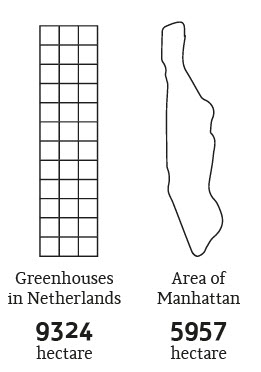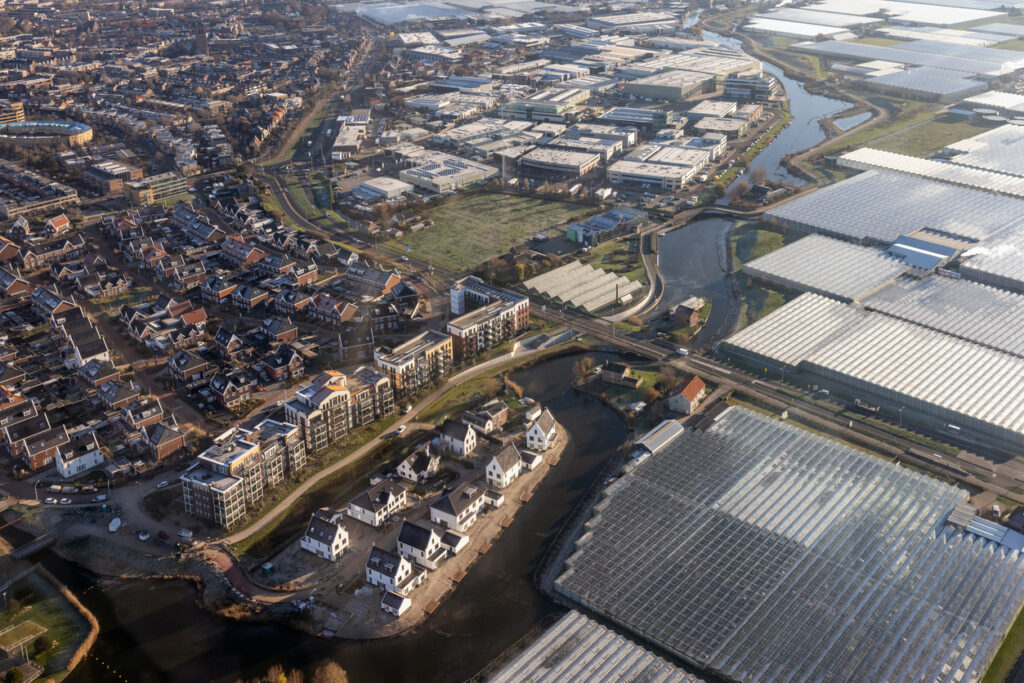Why Alberta Needs a Greenhouse Revolution

Albertans are justifiably proud of their traditional farming practices and outstanding agricultural achievements. Relying solely on seasonal crops may leave us vulnerable to unpredictable fluctuating global markets, supply interruptions, and climate events.
In times of global, social, and economic challenges, Albertans always find innovation and entrepreneurship to continue bring benefit to the world. Horticulture is one of the key sectors of the Albertan economy: our government, knowledge, educational institutes and private sector companies can work together in order to remain a leader in solving global food security and economic challenges.
Alberta (and Canada for that matter) are both facing unprecedented challenges of ensuring food security in a volatile, fast changing political and economic climate. Lowering greenhouse gas emissions to ensure a sustainable environment is also a high priority for Albertans and Canadians.
A Greenhouse Hub could be one way to move improve our position in the world food supply market. A Greenhouse Hub could provide a central location to embrace innovative agricultural solutions, and lower greenhouse energy consumption, all while increasing crop production.
Why Alberta Needs a Greenhouse Hub:
- Economic Efficiency: A Greenhouse hub could provide shared resources such as an energy network, shipping and receiving facilities, supply chain efficiencies, and sharing innovation.
- Shared Innovation: A team approach in sharing innovative ideas, discoveries, and new technologies would benefit everyone in the hub. Increased crop yield, lower water usage, pestilence resistance, could all be innovations that could be shared.
- Improved Sales and Purchasing Power: This Canadian horticultural powerhouse could represent on a global scale by stimulating, facilitating and coordinating domestic and international business relations. The organization would be business oriented, non-competitive and would leverage the strengths, expertise, and experience of the participating growers.
- Sustainability: Greenhouses offer precise environmental control, reducing water usage, pesticide application, and land requirements compared to conventional farming. Geothermal energy integration further minimizes our carbon footprint.
- Economic Diversification: A thriving greenhouse sector creates new jobs in construction, operations, research, and related industries, strengthening Alberta’s economy beyond traditional agriculture.
- Food Security: A local, year-round food supply reduces reliance on imports, making us less susceptible to price shocks and supply chain disruptions. This is crucial in a world facing increasing geopolitical instability and climate-related challenges.
- Nutritional Value: Locally grown produce is fresher and often more nutritious, contributing to the health and well-being of Albertans.
What is a greenhouse hub?
The greenhouse hub, is a concept inspired by the remarkable success of regions like the Westland in the Netherlands, also known as “Glass City.” Imagine a concentrated area teeming with cutting-edge greenhouses, research facilities, educational institutions, and businesses specializing in horticulture and related technologies. This is the essence of a greenhouse hub – a dynamic ecosystem fostering collaboration and innovation to revolutionize food production.
Key elements of a successful greenhouse hub:
- Strategic Location: Proximity to transportation infrastructure, markets, and research institutions is crucial.
- Investment in Infrastructure: High-quality greenhouses, research facilities, and supporting infrastructure are essential.
- Focus on Technology and Innovation: Embracing the latest technologies and fostering a culture of innovation are key to maximizing efficiency and sustainability.
- Collaboration and Partnerships: Building strong relationships between growers, researchers, businesses, and educational institutions is vital for knowledge sharing and driving progress.
- Education and Training: Developing skilled workforce through specialized training programs ensures the long-term success of the hub.
A promising model: The Netherlands “Glass City”
A promising model of how this could work lies in the Netherlands’ “Westland” region, a global powerhouse of greenhouse production. The Westland area has so many greenhouses, it is also known as “The Glass City”. Westland isn’t just a collection of greenhouses; it’s a tightly knit ecosystem. These operations share a geothermal energy network, utilities, and cutting-edge innovations, creating a synergy that has propelled the Netherlands to become the world’s second-largest food exporter, despite its relatively small size. This “agro-industrial complex” approach maximizes efficiency, minimizes waste, and fosters continuous improvement. Image source: Holland Greenhouse

How the Glass City got started
It wasn’t government committees, environmental groups, or venture capitalists that created the Glass City. It was a group of motivated, risk taking, cooperating Greenhouse Operators who saw the opportunity, raised the money, and took a chance. Here are the results:
- The Netherlands is the world’s biggest exporter of fresh vegetables, with 4.6 billion kilograms of vegetables exported every year.
- The Dutch annual food export measured by value, is ranked second globally, below the United States, which has a landmass 270 times as large.
- The Netherlands produces 50% of all the flowers worldwide, 25% of the plants and shrubs and 80% of the flower bulbs.
Steps to Cultivate a Greenhouse Hub in Alberta:
Here are some steps that can be taken to create a Greenhouse Hub.
- Gather a group of Committed Greenhouse operators: Alberta’s greenhouse operators are the ones that would benefit the most from a Greenhouse Hub. Based on the success in Holland, it stands that they should be the group that drives this initiative. The current February 2025 economic upheaval is creating distracted governments and increased risk for investors. These factors may delay implementation and introduce motivations that are not consumer focused.
- Build the Project Team: Build a team of people that are committed to completing a feasibility study. Members include:
- Algar Geothermal
- Greenhouse operator
- Well owner
- Engineering Partner
- Supplier of the Greenhouse Structure
- Municipality Support (town council, mayor etc.)
- Alberta Government Representative
- Federal Government supporter
- Select a location: Completing a short list of potential municipalities to locate in is step one. Next, see which town council is willing to support the project by signing on as a partner, helping to obtain funding through government programs and grants.
- Complete a Feasibility Study: Using the selected location(s), complete an analysis of local resources, market demand, and shipping opportunities for a greenhouse hub. This study should assess the viability of geothermal energy sources, access to conventional energy, water availability, and transportation infrastructure and identify vendors and government agencies that want to get involved in the pilot project.
- Infrastructure Development: Once a location is determined, building a shared infrastructure, including geothermal energy networks, utility connections, and transportation links, is crucial to attract greenhouse operators and create economies of scale.
- Investment and Incentives: The Alberta government could offer attractive incentives, such as grants, tax breaks, and loan guarantees, to encourage help Greenhouse Operators develop the greenhouse development. This could include supporting research and development into greenhouse technologies suited to Alberta’s climate.
- Collaboration and Knowledge Sharing: Establishing partnerships with Dutch experts and institutions can accelerate the transfer of knowledge and best practices in greenhouse management, technology, and marketing. Creating a platform for collaboration among greenhouse operators, researchers, and industry stakeholders is vital.
- Workforce Development: Training programs are needed to equip Albertans with the skills required to work in the greenhouse sector, from cultivation and maintenance to technology and management.
- Market Development: Building strong relationships with retailers and consumers is crucial to ensure a stable market for greenhouse-grown produce. Promoting the benefits of locally sourced, sustainable food can drive demand.

A Role for Government:
The provincial government can play a crucial role in stimulating the development of a greenhouse hub by:
- Providing funds to develop a world class Horticultural Centre: similar to the one in Holland
- Providing Start Up Funding to Greenhouse operators that want to participate: Investing in initial infrastructure projects and research initiatives can de-risk private investment and kickstart the sector.
- Facilitating Partnerships: Connecting Greenhouse Operators, technology providers, and research institutions can accelerate the formation of a collaborative ecosystem.
- Promoting Alberta Produce: Supporting marketing campaigns that highlight the quality and sustainability of locally grown greenhouse produce can increase consumer demand.
- Subsidizing Energy Costs: Ensuring that energy costs for producers are competitive with low fossil fuel costs will incentivize development in this sector.
What is the first step?
Algar Geothermal wants to build a pilot project in central Alberta. Why can’t our pilot project be the first installation to kick off the Alberta Greenhouse Hub? Using Algar’s technology to harness a geothermal heat source, and the Alberta Business Community with their ingenuity and innovation, together we can build a small scale facility and actually grow a net zero food crop.
Contact Algar Geothermal to get on board
Click here to fill out our contact form
Email the author: Blair.Shunk@algargeothermal.com
